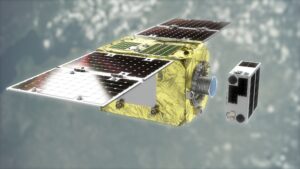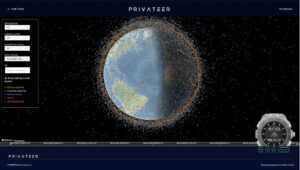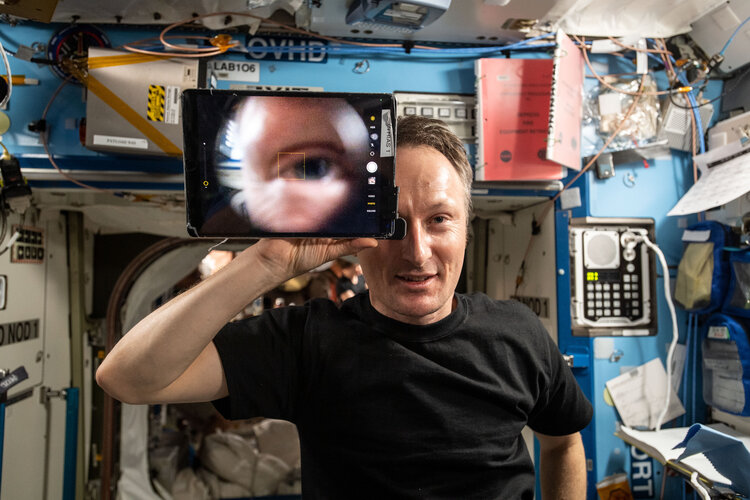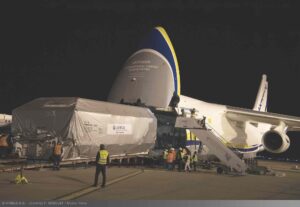Webb telescope's cool view on how stars, planets form
Thursday, 07 April 2022 20:48
The ongoing success of the multi-instrument optics alignment for NASA's Webb telescope's near-infrared instruments has moved the attention of the commissioning team to chill as we carefully monitor the cooling of the Mid-InfraRed Instrument (MIRI) down to its final operating temperature of less than 7 kelvins (-447 degrees Fahrenheit, or -266 degrees Celsius). We are continuing other activities during this slow cooldown which include monitoring the near-infrared instruments. As MIRI cools, other major components of the observatory, such as the backplane and mirrors, also continue to cool and are approaching their operational temperatures.
Curiosity Mars Rover reroutes away from 'gator-back' rocks
Thursday, 07 April 2022 20:41
NASA's Curiosity Mars rover spent most of March climbing the "Greenheugh Pediment"—a gentle slope capped by rubbly sandstone. The rover briefly summited this feature's north face two years ago; now on the pediment's southern side, Curiosity has navigated back onto the pediment to explore it more fully.
Astroscale to restart debris-removal demo with half the thrusters
Thursday, 07 April 2022 20:33
Astroscale plans to resume an attempt to capture a satellite acting as a piece of debris in low Earth orbit despite losing half the servicer’s eight thrusters.
The post Astroscale to restart debris-removal demo with half the thrusters appeared first on SpaceNews.
Getting a jump on traffic: The sudden urgency of government-industry partnerships in space traffic management
Thursday, 07 April 2022 18:25
There is a trend of growing private sector capabilities to track objects and warn of potential conjunctions.
The post Getting a jump on traffic: The sudden urgency of government-industry partnerships in space traffic management appeared first on SpaceNews.
Path to sustainable space unclear after Russia’s Ukraine invasion
Thursday, 07 April 2022 16:43
Before Russia invaded Ukraine, many considered international space cooperation safely insulated from geopolitical strife.
The post Path to sustainable space unclear after Russia’s Ukraine invasion appeared first on SpaceNews.
Starlink loses French spectrum license
Thursday, 07 April 2022 16:30
SpaceX has lost the right to provide Starlink broadband services in France after the country’s highest administrative court revoked its spectrum license.
The post Starlink loses French spectrum license appeared first on SpaceNews.
E-Space sheds more light on sustainable megaconstellation plan
Thursday, 07 April 2022 15:29
Megaconstellation startup E-Space is preparing to deploy the first of potentially hundreds of thousands of satellites on a Rocket Lab mission slated for no earlier than April 19.
The post E-Space sheds more light on sustainable megaconstellation plan appeared first on SpaceNews.
Eye on world health
Thursday, 07 April 2022 13:41 Image:
Image:
H a p p y W o r l d H e a l t h D a y
Celebrated each year on 7 April, World Health Day shines a light on a health topic of concern. This year all eyes, including ESA astronaut Matthias Maurer’s, are on the health of our planet Earth.
From on board the International Space Station 400 km above Earth, Matthias has a unique overview of our planet. Beautiful yet fragile, resilient yet under threat, our third rock from the Sun nevertheless needs looking after.
Matthias work in space during Cosmic Kiss reinforces this. Besides taking numerous
Antonov shortage threatens delivery delays for the biggest satellites
Thursday, 07 April 2022 10:58
A shortage of Ukrainian Antonov aircraft raises the prospect of more delays for satellite projects already bogged down by supply chain issues.
The post Antonov shortage threatens delivery delays for the biggest satellites appeared first on SpaceNews.
Living Planet Fellowship: Call for Proposals
Thursday, 07 April 2022 10:11Living Planet Fellowship: Call for Proposals
Lynk announces deployment of world's first commercial-ready cell-tower-in-space
Thursday, 07 April 2022 10:05 Lynk Global, Inc. (Lynk), the world's leading satellite-direct-to-phone telecoms company, has announced the successful launch, deployment, and initial on-orbit check-out of Lynk Tower 1. The spacecraft is the company's sixth 'cell-tower-in-space' satellite and is now in position to become the world's first commercial cell-tower-in-space. Lynk Tower 1 is the first satellite covered by Lynk's appl
Lynk Global, Inc. (Lynk), the world's leading satellite-direct-to-phone telecoms company, has announced the successful launch, deployment, and initial on-orbit check-out of Lynk Tower 1. The spacecraft is the company's sixth 'cell-tower-in-space' satellite and is now in position to become the world's first commercial cell-tower-in-space. Lynk Tower 1 is the first satellite covered by Lynk's appl Benchmark Space Systems triples production capacity to meet thruster and in-space mobility demand
Thursday, 07 April 2022 10:05 Fueled by major Series A funding and a strong cadence of upcoming government and commercial space missions, Benchmark Space Systems has announced it is tripling production capacity and doubling manufacturing and technical staff to meet huge demand for its Starling and Halcyon propulsion systems.
Benchmark is scaling up to build more than 150 systems over the next eighteen months to enable
Fueled by major Series A funding and a strong cadence of upcoming government and commercial space missions, Benchmark Space Systems has announced it is tripling production capacity and doubling manufacturing and technical staff to meet huge demand for its Starling and Halcyon propulsion systems.
Benchmark is scaling up to build more than 150 systems over the next eighteen months to enable UK Space Command contracts with SSTL for Carbonite+ satellite
Thursday, 07 April 2022 10:05 Surrey Satellite Technology Ltd (SSTL) has signed a 22m pound contract with Defence Equipment and Support on behalf of UK Space Command for a 150kg satellite based on SSTL's Carbonite+. Project TYCHE is the first satellite procurement for the MINERVA programme which is a key enabler in the development of the foundation for a UK Space-based Intelligence Surveillance and Reconnaissance (ISR) const
Surrey Satellite Technology Ltd (SSTL) has signed a 22m pound contract with Defence Equipment and Support on behalf of UK Space Command for a 150kg satellite based on SSTL's Carbonite+. Project TYCHE is the first satellite procurement for the MINERVA programme which is a key enabler in the development of the foundation for a UK Space-based Intelligence Surveillance and Reconnaissance (ISR) const York Space Systems wins 2nd major contract from Space Development Agency
Thursday, 07 April 2022 10:05 York Space Systems (York), a Denver-based aerospace company dedicated to complete space mission solutions, has announced another award from the Space Development Agency (SDA), a $382 million contract to York to deliver 42 satellites in support of SDA's Tranche 1 Transport Layer (T1TL). York will produce these satellites, built on the LX-CLASS standard commercial platform, in the new facility for
York Space Systems (York), a Denver-based aerospace company dedicated to complete space mission solutions, has announced another award from the Space Development Agency (SDA), a $382 million contract to York to deliver 42 satellites in support of SDA's Tranche 1 Transport Layer (T1TL). York will produce these satellites, built on the LX-CLASS standard commercial platform, in the new facility for Tianzhou 2 re-enters Earth's atmosphere, mostly burns up
Thursday, 07 April 2022 10:05 China's Tianzhou 2 cargo spaceship fell back to Earth on Thursday afternoon with most of its body burnt up during the reentry process, according to the China Manned Space Agency.
The agency said in a statement the robotic craft started to enter the atmosphere around 6:40 pm under the ground control and the extreme heat caused by air friction dismantled and destroyed most of the ship. A few
China's Tianzhou 2 cargo spaceship fell back to Earth on Thursday afternoon with most of its body burnt up during the reentry process, according to the China Manned Space Agency.
The agency said in a statement the robotic craft started to enter the atmosphere around 6:40 pm under the ground control and the extreme heat caused by air friction dismantled and destroyed most of the ship. A few 
